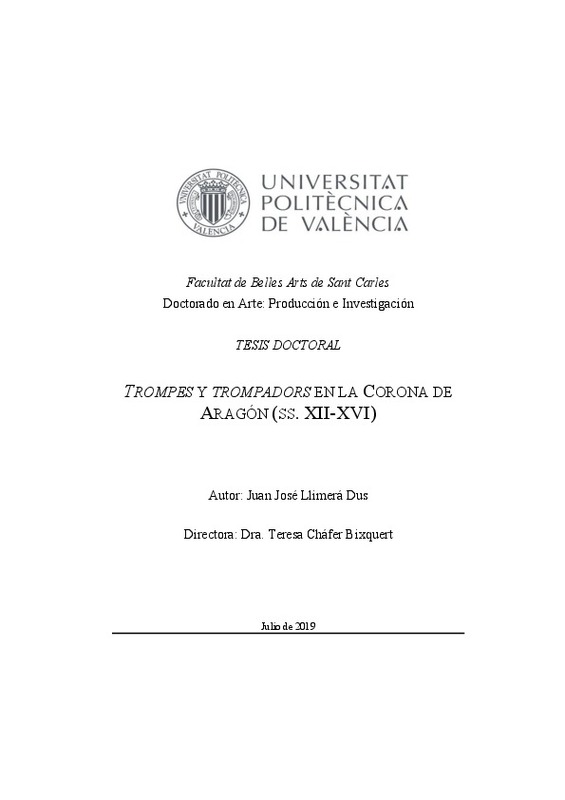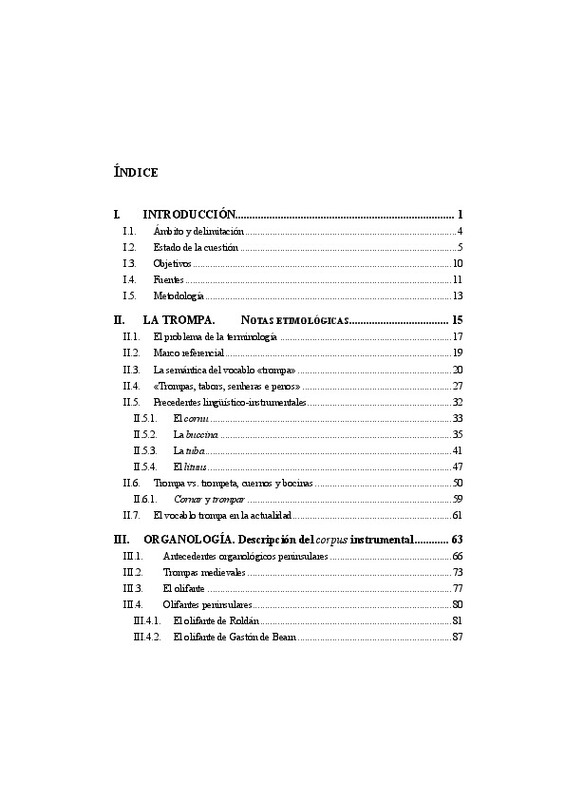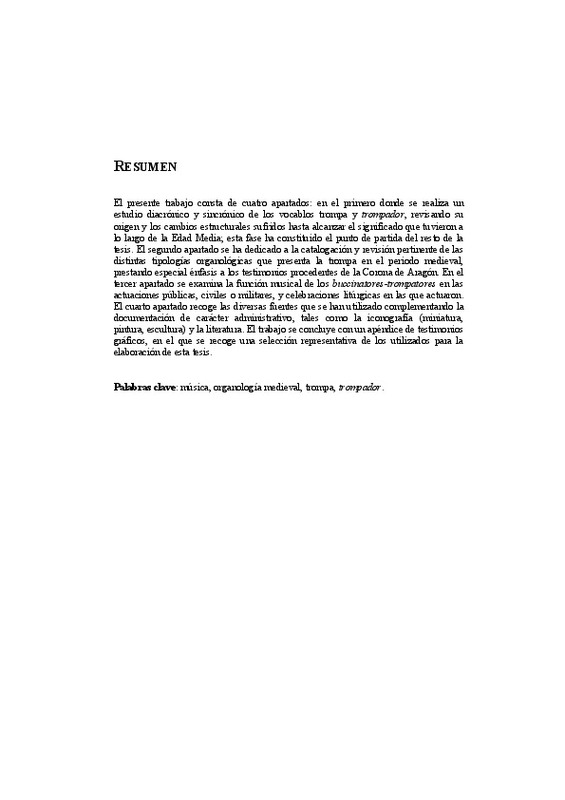|
Resumen:
|
[ES] El presente trabajo consta de cuatro apartados: en el primero donde se realiza un estudio diacrónico y sincrónico de los vocablos trompa y trompador, revisando su origen y los cambios estructurales sufridos hasta ...[+]
[ES] El presente trabajo consta de cuatro apartados: en el primero donde se realiza un estudio diacrónico y sincrónico de los vocablos trompa y trompador, revisando su origen y los cambios estructurales sufridos hasta alcanzar el significado que tuvieron a lo largo de la Edad Media; esta fase ha constituido el punto de partida del resto de la tesis. El segundo apartado se ha dedicado a la catalogación y revisión pertinente de las distintas tipologías organológicas que presenta la trompa en el periodo medieval, prestando especial énfasis a los testimonios procedentes de la Corona de Aragón. En el tercer apartado se examina la función musical de los buccinatores-trompatores en las actuaciones públicas, civiles o militares, y celebraciones litúrgicas en las que actuaron. El cuarto apartado recoge las diversas fuentes que se han utilizado complementando la documentación de carácter administrativo, tales como la iconografía (miniatura, pintura, escultura) y la literatura. El trabajo se concluye con un apéndice de testimonios gráficos, en el que se recoge una selección representativa de los utilizados para la elaboración de esta tesis.
[-]
[CA] El present treball consta de quatre apartats: en el primer on es realitza un estudi diacrònic i sincrònic dels vocables trompa i trompador, revisant el seu origen i els canvis estructurals soferts fins a arribar al ...[+]
[CA] El present treball consta de quatre apartats: en el primer on es realitza un estudi diacrònic i sincrònic dels vocables trompa i trompador, revisant el seu origen i els canvis estructurals soferts fins a arribar al significat que van tenir al llarg de l'Edat Mitjana; aquesta fase ha constituït el punt de partida de la resta de la tesi. El segon apartat s'ha dedicat a la catalogació i revisió pertinent de les diferents tipologies organològiques que presenta la trompa al període medieval, fent especial èmfasi als testimonis procedents de la Corona d'Aragó. En el tercer apartat s'examina la funció musical dels buccinatores-trompatores a les actuacions públiques, civils o militars, i celebracions litúrgiques en què van actuar. El quart apartat recull les diverses fonts que s'han utilitzat complementant la documentació de caràcter administratiu, com ara la iconografia (miniatura, pintura, escultura) i la literatura. El treball es conclou amb un apèndix de testimonis gràfics, en el qual es recull una selecció representativa dels utilitzats per a l'elaboració d'aquesta tesi.
[-]
[EN] The present work consists of four sections: in the first where a diachronic and synchronic study of the words horn and trompador is carried out, reviewing its origin and the structural changes suffered until reaching ...[+]
[EN] The present work consists of four sections: in the first where a diachronic and synchronic study of the words horn and trompador is carried out, reviewing its origin and the structural changes suffered until reaching the meaning they had throughout the Middle Ages; this phase has constituted the starting point of the rest of the thesis. The second section has been devoted to the cataloging and pertinent revision of the different organological typologies that the horn presents in the medieval period, paying special emphasis to the testimonies coming from the Crown of Aragon. In the third section we examine the musical function of the buccinatores-trompatores in public, civil or military performances, and liturgical celebrations in which they acted. The fourth section includes the various sources that have been used complementing the administrative documentation, such as iconography (miniature, painting, sculpture) and literature. The work concludes with an appendix of graphic testimonies, in which a representative selection of those used for the elaboration of this thesis is collected.
[-]
|











